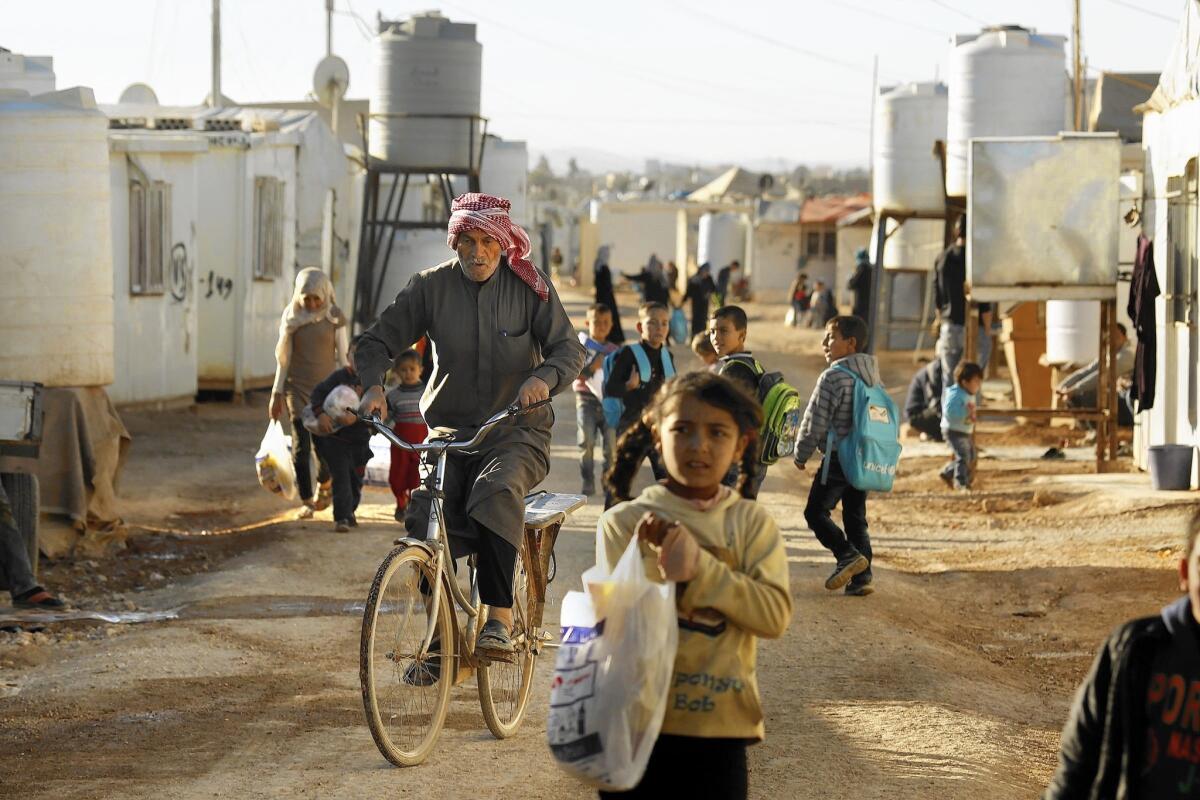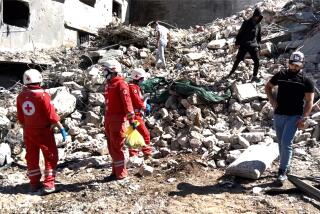Fleeing Syria: At a refugee camp in Jordan, lives are in limbo

Reporting from ZAATARI CAMP, Jordan — The child is inconsolable. She clings to her grandmother, who knows what the girl may only sense: that this could be their final embrace, here at a makeshift bus station on the fringes of a refugee metropolis.
Passengers grimly board the waiting bus. The driver, unaccountably jovial, shakes his head as he tosses bulging backpacks, duffel bags and suitcases into the baggage compartment.
“Please don’t take too much with you,” he says, knowing few will heed him.
Luggage will only complicate matters when crossing the border and negotiating rebel lines — tense moments, sometimes punctuated with sniper rounds and mortar shells.
The little girl is named Ayaa; she is 18 months old, and her grandmother is leaving. Her father, Nour al Din Dakhl Allah, his eyes red, finally wrenches her from the arms of his mother-in-law.
“Say goodbye,” he whispers. “Wish your grandmother the best.”
This bus stop on the edge of a refugee camp in the Jordanian desert has become a bleak way station in the story of Syria’s long-running civil war. Tens of thousands of migrants have streamed in since the worst of the violence began in 2012. But even with the war still raging, many have been boarding buses to go back.
A few have funerals to attend; some are homesick, or keen to reunite with loved ones. But for others, the ongoing saga of death and mayhem at home has become less unbearable than life in this camp, with its boredom and impermanence, its safe, clustered dwellings that belong to no one.
Soon, the matriarch boards the bus and looks out through the bus window, her features distorted in the smudged glass. The senseless death of another grandchild, across the border in Syria, has necessitated her doleful journey back.
Ayaa keeps her eyes fixed on the bus.
“Her grandmother reared her,” explains the father. His daughter flails her arms toward the blurry figure in the bus window.
The father leaves the bus depot and puts the girl on the handlebars of his bicycle, which kicks up dust as he pushes it deep into the warren of the camp.
::
From its highest perch, Zaatari camp extends into the distance like a shimmering mirage. White cubicles and canvas tents with blue United Nations lettering advance in orderly columns bisected by dirt lanes. Beyond the fences lies a desolate landscape of parched scrub and brown earth stretching to the horizon.
Nowhere else in the world are Syrian refugees so densely packed as in Zaatari, where 79,000 people occupy slightly more than two square miles of barren terrain. If it were a city, it would be Jordan’s fourth largest.
While international attention has focused on Syrians fleeing to Europe, relatively few of the 4 million who have left since 2011 can afford the smuggling fees and other expenses needed to get there. Most have settled in neighboring Jordan, Lebanon and Turkey, each of which houses more than 1 million displaced Syrians.
The great majority live not in formal camps, but crammed into apartments, homes and ad hoc dwellings, struggling to pay rent and feed families adrift. In a sense, those in Zaatari, overseen by the U.N., are the fortunate ones.
The camp has evolved since its founding in July 2012 from an anarchic assemblage of tents to an orderly, midsize city, infused with entrepreneurial zeal. It has two field hospitals, two supermarkets, nine schools, nine clinics, more than 80 mosques and more than 3,000 shops.
There are vegetable stands and cellphone kiosks, bicycle repair outlets and bakeries, restaurants, barbershops, beauty salons and wedding boutiques. Some shops have caged songbirds outside, a common ornament in Syria.
Mothers push strollers along the Champs Elysees, as the bustling main commercial drag is known. Each week, 80 babies are born.
These days, hardly anyone in Zaatari sleeps in tents, but rather in prefabricated trailers with satellite dishes and jury-rigged electrical wiring. Communal kitchens and shared sanitary facilities, which residents rejected, have given way to family-built toilets and simple kitchens with gas stoves in each home.
Compared with the hovels where many refugees live in Lebanon, Zaatari offers five-star accommodation. But there is no escaping the claustrophobia. Residents are fenced in. They can leave only with permission from Jordanian authorities.
As much as they can, people in the camp have struggled to re-create their lives in Syria.
“When I first got here, I didn’t know what to do,” recalls Ali Saleh Jibraail, 36, who ran a falafel shop in Damascus’ Midan district, scene of heavy fighting in 2012.
Much of Midan, including Jibraail’s falafel stand, was destroyed. Jibraail and many residents fled south to Jordan.
“I realized there was a demand here, so I decided to do what I knew to do best: falafel,” says Jibraail.
Now he is known as Abu Abdullah, and his shop, open seven days a week, is a favored hangout for both residents and camp staff, including international aid workers and Jordanian police officers. He’s known throughout the camp for his version of falafel.
With proceeds from his bustling food stand, Jibraail could have arranged for his family — two wives, two daughters, four sons — to make the journey to Europe. But he thought the trek too hazardous. Besides, he says, life here is not so intolerable.
“The main problem here is that there’s not enough work for people, not enough to do,” Jibraail says. “I employ as many as I can, but most people have nothing to do, even if their basic needs are taken care of.”
He escorts a pair of visitors to his modular home, a block away. He has replaced the drab white front with a multi-hued facade suggesting a substantial, if rustic, Syrian abode. Inside, he is building a fountain of blue tile, like the ones that tinkle in the courtyards of Syrian villas.
::
Across the Champs Elysees, in a side street of identical white modules, Ibrahim Hariri and his family reflect on their more than three years at Zaatari. They are members of the prominent Hariri tribe from southern Syria’s Dara province, where most of Zaatari’s residents have their roots. More than 3,000 members of the Hariri clan now live in the camp, relatives said.
Like other extended families here, many have arranged their trailers to be near loved ones, creating tight-knit, self-supporting hamlets amid the camp’s sprawl.
“I would go back in a minute if I could,” says Hariri, 62, a retired policeman.
When he and loved ones fled three years ago, he says, “we expected to be gone for one month. Now all these years later, we are still here. Maybe I will go back soon.”
His mother, 85, and father, 90, are here, along with six children and 26 grandchildren. They all live nearby, mostly in adjoining cubicles. Like so many others, he complains of boredom and a sense of being penned in. He passes the days chatting with relatives, catching up on family gossip and sharing the latest news from Syria.
“To some extent we have managed to re-create the life we had in Syria,” says Hariri, wearing sandals and a beige smock. A red-and-white checked scarf is wrapped around his head. “To be truthful, I don’t feel comfortable when I leave the camp anymore. I want to be back.”
All here have seen the televised images of Syrians packed into boats bound for Europe — and of the often tragic aftermath as flimsy craft capsized at sea.
His son, Mutaa Hariri, 35, draws on a water pipe in the family residence, where carpets cover the floor. “If we had a chance to go legally, say to Canada or to Europe, of course we would go,” he says. “But we saw the pictures of the bodies of drowned kids washing up on shore. We don’t want that to happen to our children.”
Outside, children with blue backpacks imprinted with UNICEF logos are arriving home from school. Fayza Hariri, Ibrahim’s wife, hugs several of her grandchildren. “I want them all before me,” she says.
::
These days, the predictability of camp life contrasts dramatically with a daily drama unfolding at the camp’s small transport depot, where the buses leave for Syria.
Last summer, at the height of the migrant crisis, as many as 500 people a week boarded the buses. Some, despairing of any future in Jordan, elect to go home, whatever the risk. But many others are bound for Europe via Turkey, preferring to travel through Syria, with all the risks, rather than buy expensive plane tickets from Amman to Istanbul.
U.N. personnel try to dissuade everyone from returning.
“We tell them it’s not safe to go to Syria,” said Sophie Etzold, U.N. associate protection officer at Zaatari. “But we can’t force them to stay. At the end of the day it is their decision.”
::
Summar Obeid, 25, arrives at the depot with her four children, three boys and a girl, and three huge bundles of belongings. She is wearing a thick glaze of makeup, heels, a well-cut black dress. Her hand is festooned with henna tattoos.
This is a big day, but not one she has looked forward to. Obeid is going back to Syria to be reunited with her husband, whom she hasn’t seen in five years. But to do it she must pull her children from the safety of the camp.
“My husband doesn’t know his son,” she says, pointing to 5-year-old Laith. “He left when Laith was only 13 days old.”
Jordanian authorities refused entry to her husband for security reasons, a common problem here. Many men whose families have fled Syria have served with armed militias. Jordan is keen to keep the conflict on the other side of the border.
“I’m cut through with fear, but what else can I do?” Obeid says. “The children need to know their father.”
Also making the trip with six of his nine children is Yasser Massalmeh, a 40-year-old truck driver.
For years, he and his six brothers made a living trucking produce through the region, mostly hauling vegetables from Jordan to Iraq, until it became too dangerous. He and his brothers sold their trucks, and he is going home to Dara.
“I know it’s dangerous,” he says, fingering worry beads. “There’s bombing all the time. Everyone is there. Al Qaeda, Russia, Hezbollah.”
He plans to throw up some tents on a family plot and try to wait out the war in the countryside, planting crops for food.
“I’d rather live in a tent in Syria than in a tent here,” he says.
::
This is the same bus that will carry Fayzeh Qaddah, the grandmother of little Ayaa Dakhl Allah, back to Syria. The family fled their village in Dara in the spring of 2012.
Qaddah’s daughter Nawal was distraught over her mother’s departure. “Who is happy to see someone return to the place of death?” she said.
Qaddah’s return was prompted by the death of her 4-year-old grandson, Mohammed, who had been run over by a water truck.
Only a few months before, another grandson, Safwan, 9, had been asleep in his bed as rebels fired celebratory rounds.
A stray bullet struck him in the head. He never regained consciousness.
Nawal Qaddah has no illusions about life on the other side.
“Of course, we’d all love to go back to Syria,” she says. “But what if a shell comes and splits our children in two? What would we do then?”
Zaatari may be imperfect. But for now it will remain home, because home — the Syria she left — is a place that exists now only in collective memory.
Special correspondent Nabih Bulos contributed to this report.
More to Read
Sign up for Essential California
The most important California stories and recommendations in your inbox every morning.
You may occasionally receive promotional content from the Los Angeles Times.










